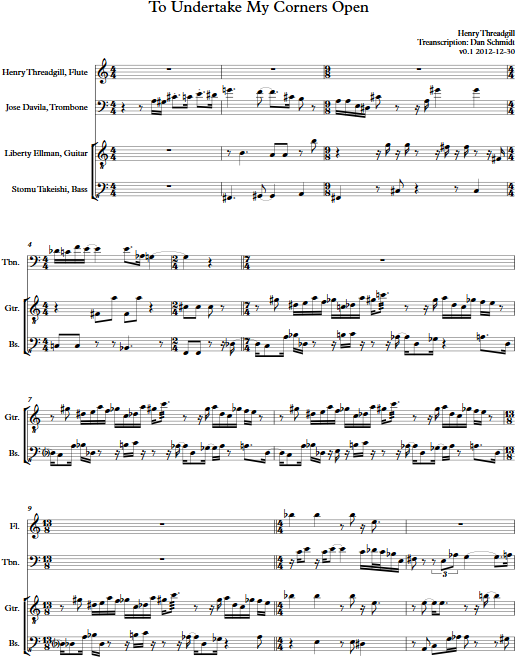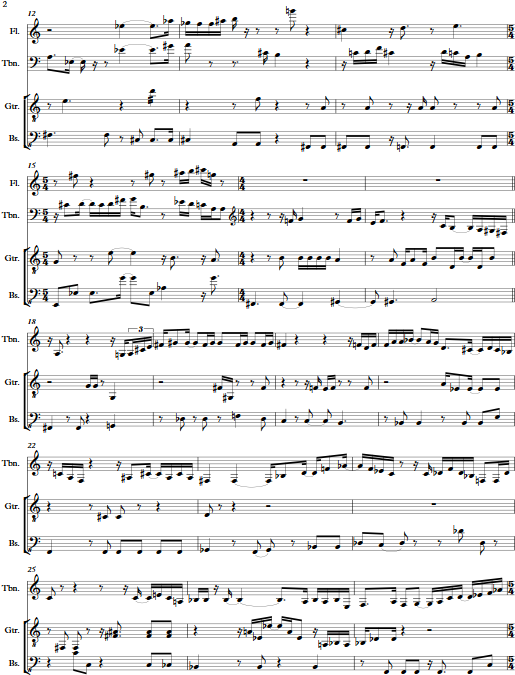Henry Threadgill’s Zooid group has made some really interesting recent music in an original musical language, but I’ve seen very little discussion of what the language is, and Threadgill himself doesn’t seem to be very forthcoming. The best description I’ve found comes from guitarist Liberty Ellman in a phone conversation with Nate Chinen, but there’s still not enough detail for me to reverse-engineer it. A diagram would probably clear it all up, but it’s hard to provide a diagram over the phone!
So I started transcribing a piece to see if I could start to make some sense of it. I chose “To Undertake My Corners Open” (YouTube link) from This Brings Us To, volume 1. It’s pretty gnarly stuff, so I’m pausing a couple of minutes in to report my findings so far. If I waited until I finished the whole thing, it would be a really long time before I wrote anything, plus I would have a novel’s worth of things to say about it; this way I can write as I go, and maybe even get some feedback.
I’ve transcribed the “head” as well as the first “chorus” of the trombone solo (his solo lasts just under three cycles of a repeating bass progression). The score so far is below but it’s probably handier to look at the PDF.



Caveats: I have a pretty good ear, but this stuff is hard! It’s not particularly tonal and there are two “analog-pitch” instruments (trombone and bass). Meanwhile the guitar has nice discrete pitches but is hard to hear behind the other instruments.
The beat can be hard to identify; Threadgill tends to deliberately avoid obvious downbeats, aiming for a more homogenous pulse. I tried to switch meter only when I really had to.
I should mention that I use the fabulous Transcribe! program, and there’s no way I could have gotten remotely close to this amount of detail without it.
Does the opening phrase of the trombone remind any one else of the beginning of Berg’s Lyric Suite? Probably a coincidence, but I get the impression that Threadgill knows twelve-tone history.
I’ll come back to the head, which seems pretty through-composed, in a minute, but moving ahead to the trombone solo (the bass cycle starts at m. 18): one thing that surprised me when transcribing is that it’s a lot more normal than it sounds at first. The trombone is following the bass progression very faithfully, and even navigates it in a quite tonal manner, measures 21-27 being the clearest example. It’s mostly the guitar that colors the harmonies in an interesting and dissonant way. The thing I’m most interested to find out next is whether the guitar part’s structure is more vertical (choosing notes each measure from a harmony relative to the bass) or horizontal (charting an independent path that creates interesting harmonies by chance). Ellman’s comments give the impression that it might be the latter. Once I finish the next two choruses of this solo, I’ll have a better impression of what is consistent each time around, which will help illuminate the structure behind it.
Here’s the bass structure of the trombone solo. Like I said, it repeats three times, starting at m. 18. (I get the sense that it changes for the following guitar solo, but I haven’t listened closely yet.)

I said I would get back to the head later, and here’s why: the structure of the head is basically exactly the same but twice as fast! Even the lead-in, not pictured above, corresponds: m. 2 is mm. 16-17 at double speed.
The intro goes through one of the two G♭-D♭-C-B♭-F cycles, skips the second one, takes a weird repeated 7/4 break that could be related to the 5/4 D♭-C measure, then meets up again with the E and corresponds perfectly the rest of the way. That’s the most interesting tidbit I’ve found so far, and something I never would have noticed without writing it all out.
Note by the way that the repeated guitar figure in that 7/4 section is almost palindromic.
That’s about all I have for now. Open questions:
- What’s the structure behind the guitar lines underneath the trombone solo? Whatever it is, it seems to be changing at about the same rate as the bass progression.
- Are there any particular harmonic or melodic rules behind the through-composed head? Nothing has leaped out at me so far, but I haven’t looked very hard.
More later, I hope.
9 Comments